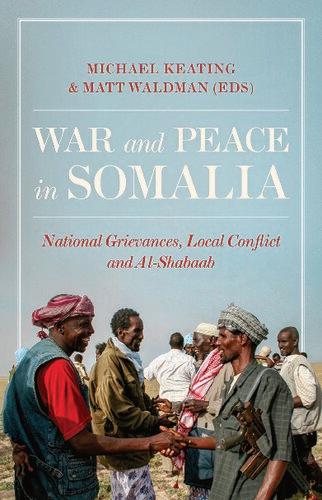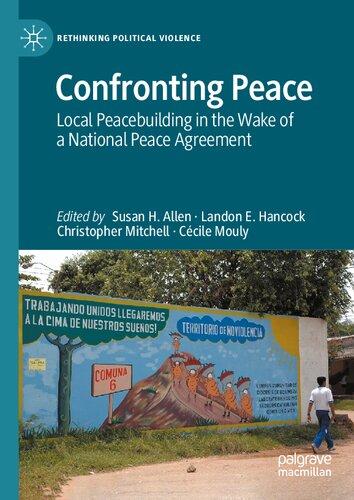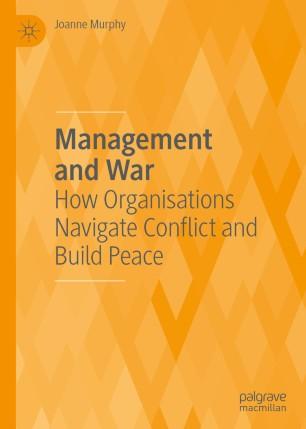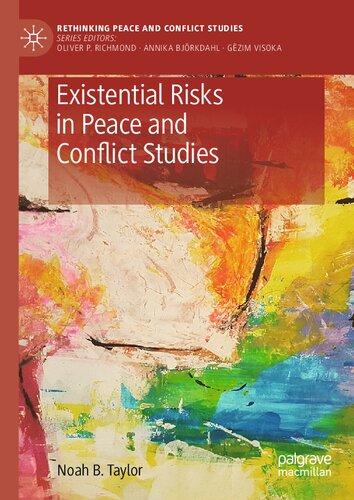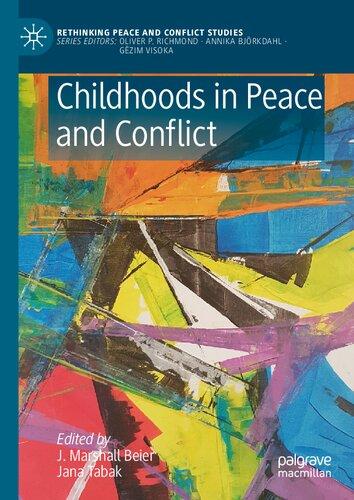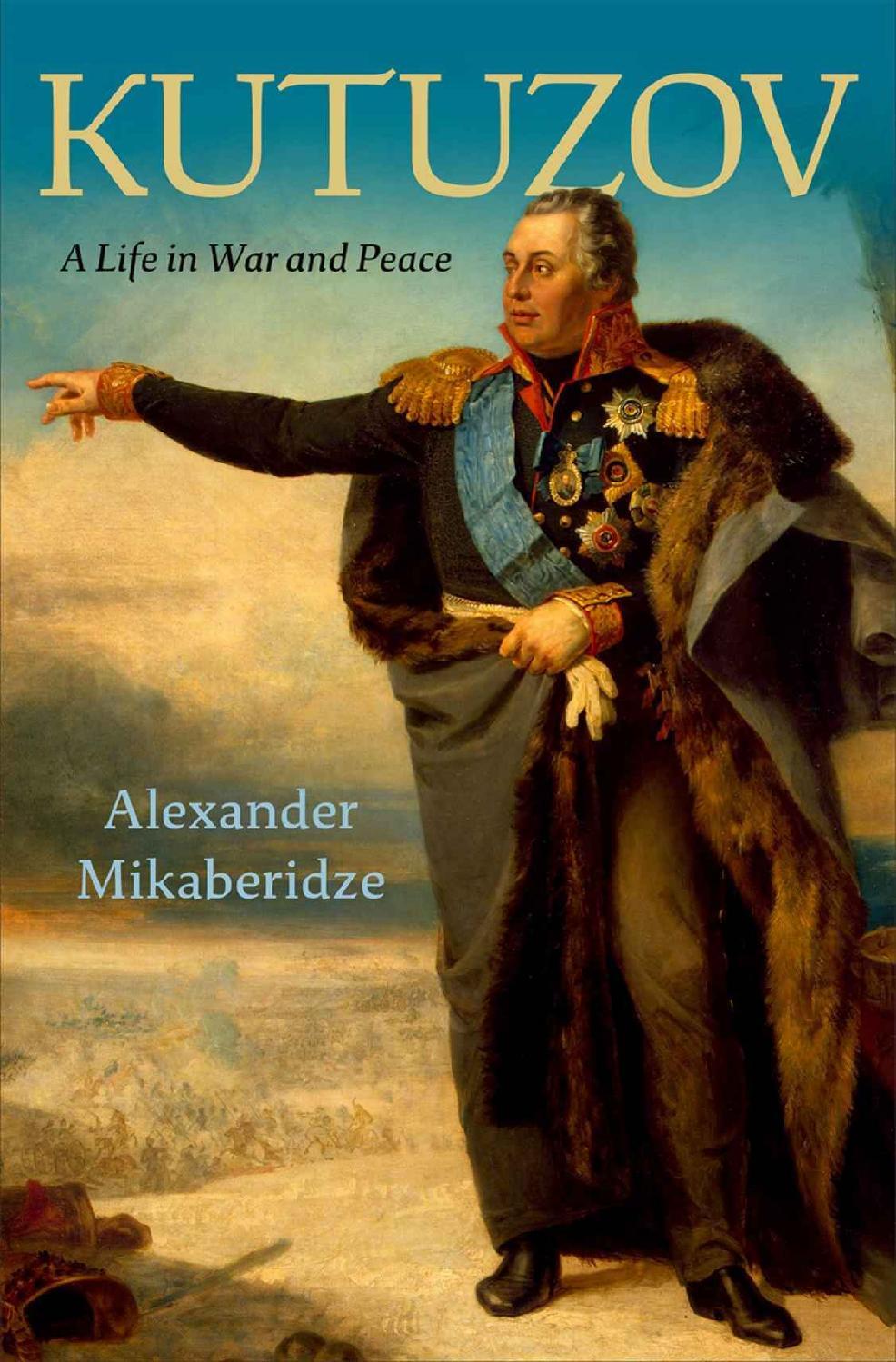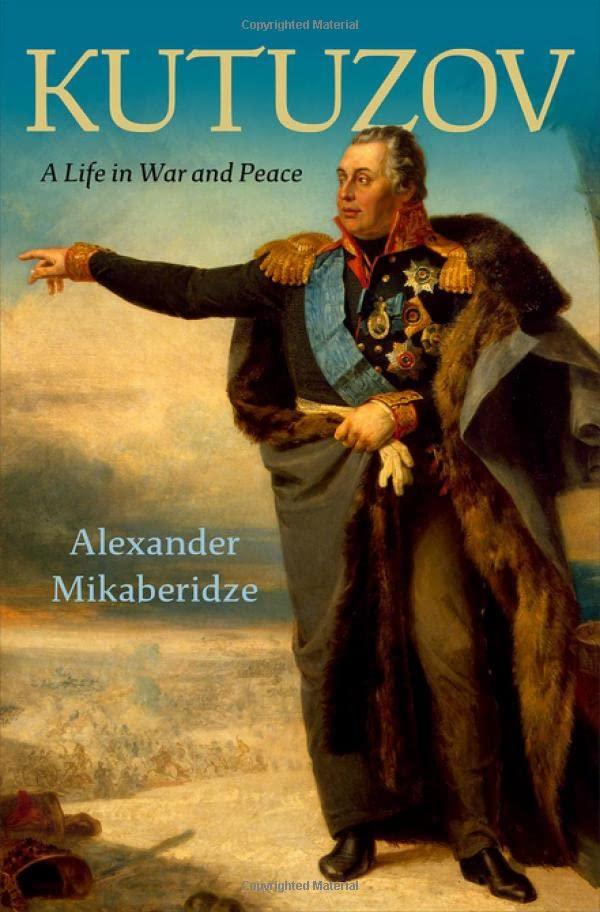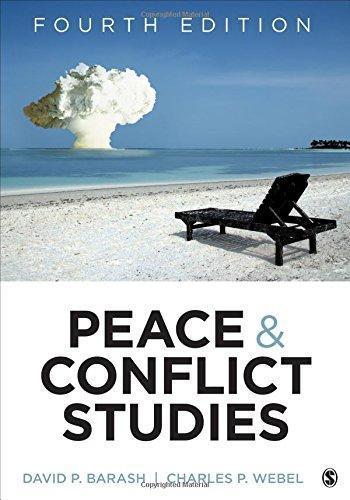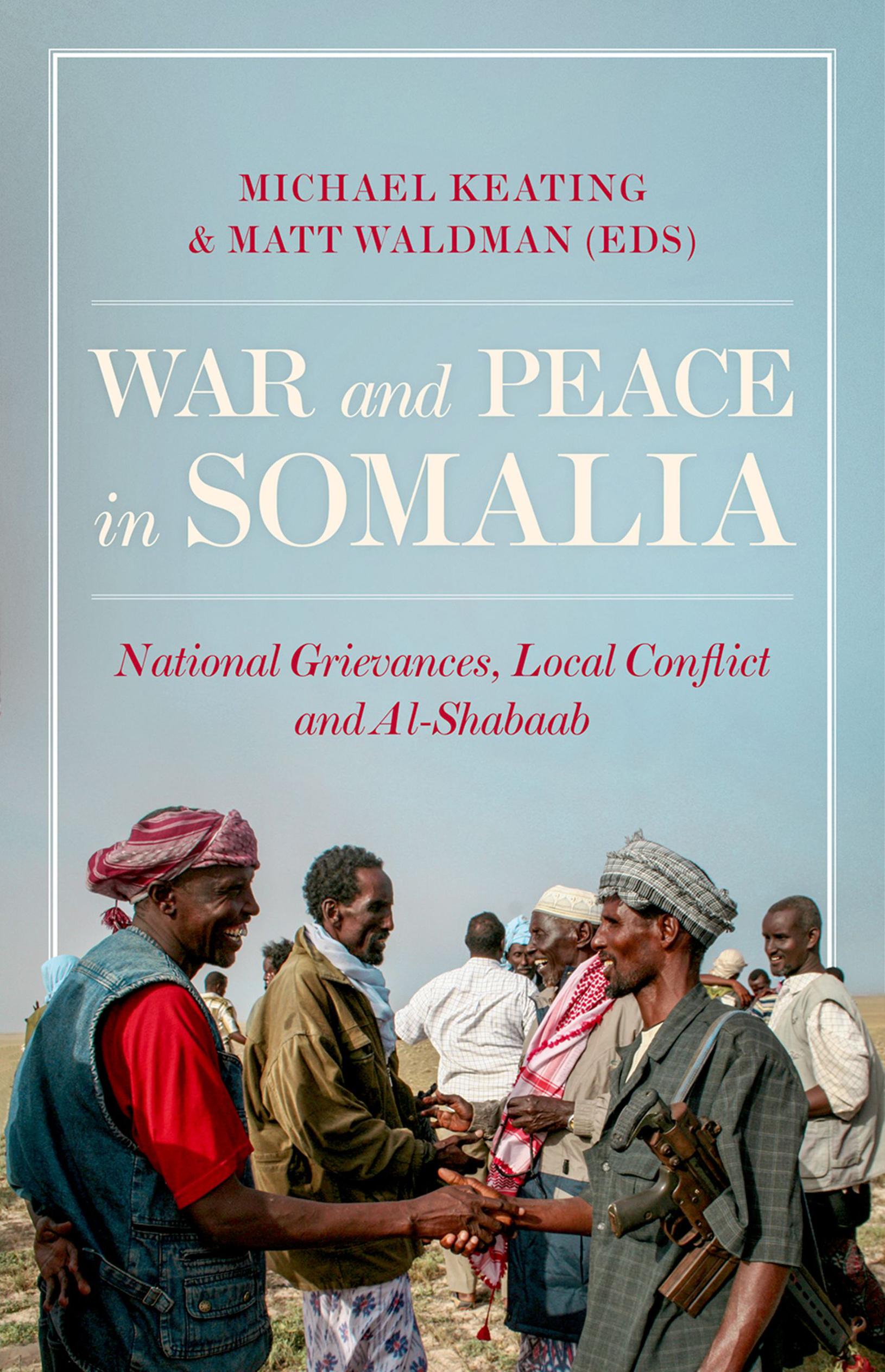War and Peace in Somalia: National Grievances, Local Conflict and Al-Shabaab Michael Keating
Visit to download the full and correct content document: https://ebookmass.com/product/war-and-peace-in-somalia-national-grievances-local-c onflict-and-al-shabaab-michael-keating/
More products digital (pdf, epub, mobi) instant download maybe you interests ...
Confronting Peace: Local Peacebuilding in the Wake of a National Peace Agreement 1st Edition Susan H. Allen
https://ebookmass.com/product/confronting-peace-localpeacebuilding-in-the-wake-of-a-national-peace-agreement-1stedition-susan-h-allen/
Management and War: How Organisations Navigate Conflict and Build Peace 1st ed. Edition Joanne Murphy
https://ebookmass.com/product/management-and-war-howorganisations-navigate-conflict-and-build-peace-1st-ed-editionjoanne-murphy/
Existential Risks in Peace and Conflict Studies Noah B. Taylor
https://ebookmass.com/product/existential-risks-in-peace-andconflict-studies-noah-b-taylor/
Childhoods in Peace and Conflict 1st Edition J. Marshall Beier
https://ebookmass.com/product/childhoods-in-peace-andconflict-1st-edition-j-marshall-beier/
Gendered Agency in War and Peace : Gender Justice and Women's Activism in Post-Conflict Bosnia-Herzegovina 1st Edition Maria O’Reilly (Auth.)
https://ebookmass.com/product/gendered-agency-in-war-and-peacegender-justice-and-womens-activism-in-post-conflict-bosniaherzegovina-1st-edition-maria-oreilly-auth/
Kutuzov: A Life in War and Peace Alexander Mikaberidze
https://ebookmass.com/product/kutuzov-a-life-in-war-and-peacealexander-mikaberidze-2/
Kutuzov: A Life in War and Peace Alexander Mikaberidze
https://ebookmass.com/product/kutuzov-a-life-in-war-and-peacealexander-mikaberidze/
1917: war, peace, and revolution Stevenson
https://ebookmass.com/product/1917-war-peace-and-revolutionstevenson/
Peace and Conflict Studies Fourth Edition – Ebook PDF
Version
https://ebookmass.com/product/peace-and-conflict-studies-fourthedition-ebook-pdf-version/
WAR AND PEACE IN SOMALIA
MICHAEL KEATING MATT WALDMAN (Editors)
War and Peace in Somalia
National Grievances, Local Conflict and Al-Shabaab
1
Oxford University Press is a department of the University of Oxford. It furthers the University’s objective of excellence in research, scholarship, and education by publishing worldwide.
Oxford New York
Auckland Cape Town Dar es Salaam Hong Kong Karachi
Kuala Lumpur Madrid Melbourne Mexico City Nairobi
New Delhi Shanghai Taipei Toronto
With offices in
Argentina Austria Brazil Chile Czech Republic France Greece
Guatemala Hungary Italy Japan Poland Portugal Singapore
South Korea Switzerland Thailand Turkey Ukraine Vietnam
Oxford is a registered trade mark of Oxford University Press in the UK and certain other countries.
Published in the United States of America by Oxford University Press
198 Madison Avenue, New York, NY 10016
Copyright © Michael Keating and Matt Waldman, 2018
All rights reserved. No part of this publication may be reproduced, stored in a retrieval system, or transmitted, in any form or by any means, without the prior permission in writing of Oxford University Press, or as expressly permitted by law, by license, or under terms agreed with the appropriate reproduction rights organization. Inquiries concerning reproduction outside the scope of the above should be sent to the Rights Department, Oxford University Press, at the address above.
You must not circulate this work in any other form and you must impose this same condition on any acquirer.
Library of Congress
Cataloging-in-Publication Data is available
ISBN: 9780190947910
Printed in the United Kingdom
Foreword President Farmaajo ix
Preface Michael Keating xi
Introduction Michael Keating and Matt Waldman 1
Overview 9
ADDRESSING THE PAST: IMPUNITY, ILLEGITIMACY AND EXCLUSION
Looma Dhama: Political Inclusivity in the Somali Urban Context Ken Menkhaus and Ismahan Adawe 31
Neither Inevitable nor Accidental: The Impact of Marginalization in Somalia The UN Accountability Project—Somalia 41
Governing Endemic Crises: Violence and Legitimacy in the Lives of Somalis Jutta Bakonyi 49
Remedying the Legacy of State Collapse: Thinking Through and Beyond Somali Civil War Violence Lidwien Kapteijns 61
Ending Impunity: Fostering Redress and Accountability in Somalia
Tobias Hagmann and Mohammed Mealin Seid 71
UNDERSTANDING LOCAL CONFLICT AND DEVELOPING EFFECTIVE RESPONSES
Achieving Local Reconciliation in Somalia Peace and Development Research Center (PDRC) 83
CONTENTS
State-building Amidst Conflict: The Urgency of Local Reconciliation
Najum Mushtaq, Life and Peace Institute 93
Supporting Local Reconciliation: Lessons Learned Across the UN System Adam Day, Centre for Policy Research, UN University 105
Local Reconciliation in Somalia: The Prospects for Sustainable Peace
Abukar Sanei and Mohamed A. Omar Center for Policy Analysis and Research (CfPAR) 117
Exploitation of Natural Resources as a Driver of Conflict: Case Study on Mining in Baki District, Somaliland
Mohamed Abdi Omer and Mohamed Farah Hersi, Academy for Peace and Development (APD) 127
Traditional Peacemaking in Sanaag Region, Somaliland
Abdullahi Odowa, Observatory of Conflict and Violence Prevention (OCVP) 137
The Sharia Courts of Mogadishu: Lessons for Peace and Reconciliation
Ahmed Sh. Ibrahim 147
Determinants of Success: Analysis of Peace Initiatives in South-Central Somalia
Galymzhan Kirbassov, UNSOM Integrated Analysis Team 155
AMISOM: Challenges of Influence, Impartiality and Disengagement
Najum Mushtaq, Life and Peace Institute 167
PROMOTING NATIONAL PEACE AND RECONCILIATION
Reconciliation in Somalia: Reform, Representation and Responsibility
Aden Abdi and Alexander Ramsbotham, Conciliation Resources 179
Launching Reconciliation in Somalia Joakim Gundel 191
State-building and Peacebuilding in Somalia: Lessons from Other Peace and Transition Processes
Thania Paffenholz, Constance Dijkstra and Andreas Hirblinger, Inclusive Peace and Transition Initiative 203
Somali National Reconciliation: Exploring a Comprehensive Approach
Abdurahman Abdullahi “Baadiyow” 215
Challenges and Opportunities: Political Dialogue Between the Federal Government of Somalia and Somaliland
The Centre for Humanitarian Dialogue (HD) 227
THE HUMAN DIVERSITY OF CONFLICT: WOMEN, MEN AND YOUTH
Beyond Principles: The Inclusion of Somali Women in Peacemaking
Judith Gardner, Life and Peace Institute
Women in Al-Shabaab “Khadija” and Stephen Harley, Krypteia
From the Margins to the Centre: Somali Women in Peacebuilding
Hamdi Mohamed, ASAL Consulting
Women in Peacebuilding in Somalia
Sahro Ahmed Koshin, Somali Institute for Development Studies and Research Analysis (SIDRA)
Between a Rock and a Hard Place: Young Somali Men Today
Judy El-Bushra, Judith Gardner and Adan Abokor, Rift Valley Institute
239
251
257
265
275
Addressing the Gap: Promoting Youth Inclusion in Somali Peace and Reconciliation Sagal Aziz Deria, Erin Gillette, Katherine Henshaw and Savannah Simons, Transparency Solutions 285
UNDERSTANDING AND RESPONDING TO AL-SHABAAB
Somalia’s Southern War: The Fight Over Land and Labour
Catherine Besteman and Daniel Van Lehman
Why They Fight and Why They Quit: An Analysis of Interviews with Current and Former Al-Shabaab Fighters
Richard Barrett, Global Strategy Network
Youth Radicalization: Causes, Consequences and Potential Solutions
Hussein Yusuf Ali
299
309
319
329
Al-Shabaab’s Youth Recruitment Project
Mohamed Haji Abdullahi “Ingiriis” 339
Rivals in Governance: Civil Activities of Al-Shabaab
Roland Marchal 349
Can Al-Shabaab Deliver? Reality and Rhetoric in the Struggle for Power
Richard Barrett, Global Strategy Network 359
Is Anybody Listening? Al-Shabaab’s Communications
Anatomy of Counter-Jihad: Community Perspectives on Rehabilitation and Reconciliation
Stig Jarle Hansen, Linnéa Gelot and members of the ISHA human rights group 379
INTERNATIONAL ASPECTS OF AL-SHABAAB
Al-Qaida and Al-Shabaab: A Resilient Alliance Tricia Bacon and Daisy Muibu 391
Al-Shabaab as a Transnational Security Threat Sahan Africa 401
Foreign Fighter Influence in Al-Shabaab: Limitations and Future Prospects Tricia Bacon and Daisy Muibu 413
Travelling for an Idea: The Appeal of Al-Shabaab to Diaspora in the West Joshua Meservey 425
ENGAGING WITH AL-SHABAAB
Negotiations with Al-Shabaab: Lessons Learned and Future Prospects
Harmonie Toros and Stephen Harley, Krypteia 437
Community Perspectives Towards Al-Shabaab: Sources of Support and the Potential for Negotiations
Joanne Crouch and Abdi Ali, Saferworld 449
Al-Shabaab Attitudes Towards Negotiations
Anneli Botha and Mahdi Abdile, The Network for Religious and Traditional Peacemakers 461
AID, BUSINESS AND RECONCILIATION
Collaborating for Peace: An Analysis of Networks of Cooperation in Somalia Dominik Balthasar and Anja Osei, Swisspeace 477
Insights from Network Analysis in Somalia
Mircea Gherghina, Sandra McNeill and Khadir Abdi, Transparency Solutions 489
Business-Led Peacebuilding in Somalia
Bahar Ali Kazmi and Faisa Abdi Loyaan, Creative Alternatives Now 501
FOREWORD
confrontation, to find and build on shared values, and even be prepared to engage in dialogue with those we see as adversaries. We must also talk and listen to all those Somalis who are affected by the decisions of those who hold power. My Government is committed to this agenda and to restoring hope to Somalis, including by crafting a national reconciliation plan to which all stakeholders can contribute.
Peace can never be achieved if we do not fully understand the causes, complexity and dynamics of the many conflicts that blight our nation. That is why I commend the work of the United Nations, supported by the Government of Norway, and all of the Somali and international researchers and experts who contributed to this portfolio. A greater understanding of the challenges we face today will enable us to chart the path to a more peaceful and prosperous future.
PREFACE
Michael Keating, Special Representative of the United Nations Secretary-General for Somalia and Head of the United Nations Assistance Mission in Somalia
In recent years, Somalis have increasingly turned to political dialogue to thrash out their differences. Progress is often precarious and unpredictable, characterized by clan-based calculations and deals among powerful actors. To achieve sustainable peace and establish a functional state, this dialogue needs to be more inclusive and address many grievances and disputes around the country.
Political dialogue has nevertheless delivered results: a provisional constitution, the establishment of Federal States, an Upper House of Parliament that represents the country’s regions and not just its clans, an electoral process in 2016 that was limited but more inclusive than any since 1969, transitions of central power, a national development plan, and agreement on the national security architecture.
Those who use violence to advance their goals jeopardize this arduous political journey, and threaten the safety and well-being of all Somalis. Most obviously, Al-Shabaab has chosen that course.
L ike other Somalis, members of Al-Shabaab hold views about basic issues such as the nature of the state, foreign involvement, the administration of justice, and the role of women in society. But they use large-scale violence, terror, coercion and intimidation to advance their agenda.
The consequence is that thousands of Somali men, women and children have been killed and injured, up to one in four Somalis have been internally displaced, and millions have lost their livelihoods.
Regrettably, it is not only extremists who generate violent conflict in Somalia. The country is blighted by a multiplicity of local and regional conflicts, often over land, resources and power. Too often adversaries turn to force to advance their interests.
Those who have power—whether political, military, social or economic— often abuse it in ways that create or perpetuate grievances and injustices that fuel conflict. Mistreatment, misrule, corruption and marginalization sow the seeds for violence.
The resulting insecurity has compromised progress in every sphere, hampered Somalis’ extraordinary entrepreneurial skills and undermined confidence in the future of the country. Somalis are among the poorest people in the world. Young people have limited opportunities. Half the population faces chronic food insecurity and live in conditions that are unacceptable in the twenty-first century.
Resolving conflict and reducing levels of violence are therefore the greatest challenges facing Somalia.
International actors are implicated in many ways, motivated variously by their own security priorities, strategic interests, and rivalries. But blaming the country’s woes on external actors is inadequate. It is up to Somalis, both men and women, to forge their own pathway to peace.
The role of the United Nations is to support Somalis in this task and enable them to assume greater control over their own destiny. The UN does this by facilitating dialogue, providing strategic and technical advice, promoting norms and rights-based approaches, supporting the emergence of accountable institutions, sharing global experience, and mobilizing the support of international actors, governmental and civil society. Our role is also to help create space for processes which are best pursued exclusively by local actors.
But the most basic ingredient for conflict resolution and state-building is the willingness of Somalis, especially those with power, to choose dialogue over violence. This is essential in order to prevent further conflict and achieve lasting peace.
Achieving peace also depends on a political and practical strategy to resolve conflict and address the drivers of violence. This strategy must be Somali-led and owned. It should draw upon the cumulative experience and knowledge of experts and practitioners, Somali and international. It is in that spirit that we share this collection of papers.
INTRODUCTION
Michael Keating and Matt Waldman
This volume is part of an Initiative of the United Nations Assistance Mission in Somalia (UNSOM), overseen by Michael Keating and directed by Matt Waldman.1 The Initiative has been implemented with the support of the Government of Norway and in consultation and collaboration with the Federal Government of Somalia. The Initiative has several key goals. Above all, it is intended to serve as a resource for the government, and to ensure that national, international and UN policy-making is well informed, up-to-date and improves the prospects for peace. The Initiative seeks to contribute to an informed debate within Somalia about how to reduce violence. It is also hoped that the Initiative will contribute to the establishment of diverse, multidisciplinary communities of practice, whose expertise could help to generate a more peaceful future for Somalis.
The first phase of the Initiative aims to support high-calibre research, analysis, thinking and writing on key issues relating to peace and reconciliation in Somalia and to promote wider collaboration between the UN, government and civil society. As such, the Initiative involves experts, academics, researchers, analysts and peacebuilding practitioners, most of whom have years, if not decades, of experience working on Somalia or in the field of conflict resolution. They were invited to produce concise briefing papers on issues of their choice, taking into account gaps in knowledge or common misunderstand-
ings, their particular expertise, and the potential, in any given area, for action that contributes to peace and reconciliation. They were asked to provide a deeper understanding of the conflict, and set out policy and practical steps that should be taken to reduce violence, promote reconciliation and increase the prospects for peace. To that end, many contributors have carried out field research in Somalia and neighbouring countries, including surveys, in-depth interviews, and focus group discussions, in addition to extensive desk research and analysis.
The resulting papers, most of which were written during the first half of 2017, are contained in this book. They follow a standard format, and the summary and recommendations sections of each paper have been translated into Somali and are available on request.2 Given the diverse professional backgrounds of the authors, and different means of research, the papers vary considerably in methodology and approach. The papers were not censored and do not reflect the view of the United Nations. In fact, some of them contain criticism of the UN, government and other national and international actors. We believe that a frank, open and multidisciplinary discourse is essential for acquiring a deeper and clearer understanding of the conflict. Effective support for conflict resolution in Somalia depends on such an understanding.
Somalis have endured violent conflict for three decades. The cost of the violence, whether in terms of the human and psychological harm, the social impact, economic damage, political implications, or the lost opportunities, has been incalculable. Loss, suffering and uncertainty are a daily reality for millions of Somalis. Every clan, every community and every family has paid a price.
The hopes and aspirations of Somalis depend on action to address the violence. Somalia desperately needs a more coherent, determined and effective approach to conflict resolution. Without peace, it will be difficult if not impossible to build a functional state that can generate revenues and deliver basic services, especially justice, healthcare and education, for its long-suffering population. Without stability and the rule of law, Somalia’s huge potential for commerce and entrepreneurship will be hampered, and investment will remain limited.
The starting point for progress is genuine commitment among Somali leaders to end violence and resolve differences through peaceful and inclusive dialogue. Without such will, no amount of knowledge, capacity building, or international involvement will succeed.
Securing this commitment will not be easy. Citizens and political leaders across Somalia routinely call for peace and reconciliation, but their actions, too often motivated by clan, factional and personal interests, fall short of what is required. A genuine resolve among Somali leaders to promote the safety and well-being of all Somalis, regardless of their differences, and to act in the interests of society as a whole is essential.
Successful conflict resolution in Somalia also requires a shared understanding of the country’s many conflicts. We hope the papers in this volume contribute to such an understanding. Efforts to resolve any given conflict require an awareness of its history, causes, dynamics and implications. They must also draw on a deep understanding of the parties involved in and affected by the conflict: their motivations, beliefs and perceptions, as well as their core interests and concerns.
Given the diversity and complexity of Somalia’s conflicts, the legacies of mistrust, and the weakness of institutions, there can be no one-size-fits-all approach to conflict resolution. There should be careful consideration of which actors are best placed to engage, and the approaches they should use to help prevent, resolve or mitigate conflict. This, in turn, requires an appreciation of the different interrelated strands of violent conflict in Somalia today.
The most lethal and destructive conflict is the armed insurgency conducted by Al-Shabaab against the state. This will require a multi-pronged approach. A key element will be effective operations carried out by national and foreign security forces, acting in a professional, disciplined and coordinated way.
The success of the African Union Mission in Somalia (AMISOM) and Somali troops, at great human sacrifice, in expelling Al-Shabaab from the main population centres has resulted in the group adapting its military tactics and broader modus operandi. Al-Shabaab exploits the weakness of government and uses coercion, intimidation and persuasion to undermine state authority at every level.
Progress against Al-Shabaab will depend not just upon military and counter-terrorist operations but also on a broader political strategy. This political strategy should include engagement with a wide range of Somalis in order to promote involvement in peaceful politics, challenge extremist interpretations of Islam, and discourage the use of violence or coercion. The strategy must prioritize efforts to address the issues that Al-Shabaab exploits, especially corruption, the abuse of power, the absence of the rule of law, and lack of educational and job opportunities for young people. It should seek to curtail abuses by security forces.
Furthermore, the strategy cannot succeed without more effective efforts to resolve the many conflicts on which Al-Shabaab thrives, often by aligning itself with the weaker of two or more local adversaries.
O ver years, in many parts of Somalia, conflicts have arisen between factions, communities, clans and sub-clans, often relating to disputes over land, power, resources and revenues. The origin of many conflicts predates the emergence of the federal state but some, such as the conflicts in the cities of Galkacyo or Dhusamareb, have been exacerbated by the federal state-building process.
Conflicts draw on deep-seated grievances generated by past atrocities, land grabs, forced displacement and misgovernance. Violence has been reinforced by discrimination, marginalization, the oppression of minorities, and the abuse of human rights. The perpetrators have often benefited from impunity. Certain actors on all sides have perpetuated or aggravated conflict for their own gain or advantage.
These conflicts and grievances are being accentuated by profound demographic changes and intense pressures on Somali society. Nearly half of the population is under 15 years of age. The use of new technologies and social media is booming. Rapid, unplanned urbanization is being accelerated by environmental degradation, weather-related shocks and internal displacement. Long-established traditions and livelihoods are in jeopardy, traditional social structures are under strain and the roles of young men and women are changing. Social and cultural expectations of boys and men have evolved as a result of decades-long cycles of violence and insecurity. Limited opportunities for young men to fulfil these expectations in a peaceful way has increased their tolerance of violence and vulnerability to extremism.
Differences and disputes in Somali society are not new. But over years of conflict, and in the face of these pressures, Somalia’s traditional dispute resolution mechanisms, especially the clan system and customary law known as xeer, are being eroded.
A national strategy and framework for peace and reconciliation is therefore urgently required. The strategy should benefit from experience in Somalia and around the world, support local capacities for conflict resolution, and incorporate mechanisms for establishing truth and accountability. The strategy should seek to ensure that local reconciliation efforts identify and utilize sources of leverage and influence, while also developing resilience to threats posed by spoilers, and actors with vested interests in the war economy.
In most cases, peace and reconciliation efforts should be led by local actors, not just by power brokers but by community leaders, business, women and
youth. Civil society and non-governmental organizations have a crucial role to play. National or international actors must therefore do more to enable and support these efforts, while recognizing that direct involvement can sometimes complicate or even undermine progress.
Major regional disputes have often been dealt with by Mogadishu and the diplomatic community by brokering bargains between power holders. These agreements often involve the allocation of official positions, whether in government, the security forces or civil service, and the sharing of resources and security assets between clan elders and power brokers, especially those who have coercive capacity. But power-sharing agreements that are reached without the involvement and agreement of those who are affected by them will be fragile and potentially unsustainable.
The key to achieving the peaceful resolution of many disputes is to ensure that all those who have a stake in peace—including young people, women, minorities, businesses and professional groups—are consulted and have a say in decision making. Politicians and power holders must be open to consultation, and support the creation of safe spaces and channels for inclusive dialogue.
The role of women as both agents and resolvers of conflict has been underestimated. Conflict resolution and reconciliation processes in Somalia are dominated by powerful men. Women align with family, clan, and factional interests as much as men do—but they have a major potential role in resolving conflict that has been overlooked, including through distinctive contributions, collective action, and strategic thinking.
Somali disputes are best resolved by Somalis. As illustrated by papers in this volume, some of the most successful mediation efforts in the country have benefited from having limited or no foreign involvement.
There are cases, however, that involve powerful actors or that relate to federal issues, state formation or cross-border concerns that may benefit from the involvement of the United Nations and international partners. This could involve logistical, facilitation or diplomatic support for inclusive dialogue. The United Nations, in particular, is entrusted by the UN Security Council to use “good offices” to support the Federal Government of Somalia’s peace and reconciliation process.
Where appropriate, input could be provided in areas such as process design, mediation, capacity building and confidence building. Support might also relate to securing political or diplomatic backing for a process, managing spoilers, and the implementation or monitoring of agreements.
Somali conflict resolution efforts will benefit from coherent and sustained international and regional support for the stabilization of the country and a
comprehensive approach to security. Key partners include the African Union, Intergovernmental Authority on Development and the principal financial investors in Somali security, including the European Union, United Kingdom, United States, Gulf states and Turkey. Their willingness to cooperate on plans and priorities agreed by the Somali leadership, both in the Federal Government and Federal Member States, will be a key determinant of success.
For many years, there has been a high degree of unity in the UN Security Council about the need for peace and reconciliation in Somalia. The challenge is to leverage that unity to encourage and enable Somali politicians and power brokers to resolve their differences, as well as to protect Somalia from the effects of rivalries between international actors.
The international community should be more deliberate in the way it uses its financial, development and humanitarian assistance with a view to addressing long-standing grievances, reducing the displacement and marginalization of certain groups, encouraging the peaceful resolution of disputes that arise in the course of the federal state building process, and consolidating political agreements.
Indeed, looking ahead, conflict prevention should be a major priority for Somalia. Several major decision-making processes should be approached from a “do no harm” perspective, and should prioritize the avoidance of conflict. In fact, they should be seen as opportunities for strengthening reconciliation.
The most important such process is perhaps the revision of the provisional federal constitution which governs the respective powers of the President, Prime Minister, Upper House and House of the People, as well as of the Federal Government and Federal Member States. Consequential decisions will need to be made about resource and revenue sharing between the Federal Government and Federal Member States; the electoral model and strengthening political accountability; building professional national security forces; agreeing and strengthening the justice and corrections system; and developing the national educational curriculum.
These decisions require genuine dialogue with all Somali stakeholders, whose views, concerns and aspirations must be taken seriously. If mishandled, and perceived as illegitimate, such processes could further divide Somali society. If handled well, they could form the foundation stones of a more stable and prosperous future.
The United Nations is committed to peace and reconciliation in Somalia. This volume complements the findings of the Consultative Conference on National Reconciliation held in Mogadishu in June 2017 and a Colloquium
on Peace and Reconciliation held in Mogadishu in February 2018. We hope the volume serves as a resource in the development of the Federal Government’s national reconciliation strategy and framework, and that it contributes to the emergence of a collaborative network of experts, practitioners and officials. We will continue to work with international partners and the Somali government at the national and state levels to promote inclusive dialogue and to advance the prospects for peace.
Mogadishu, January 2018
OVERVIEW
The following section provides a brief overview of the papers in this volume. It attempts to highlight some of the authors’ key points in a single paragraph for each paper. The observations are therefore necessarily simplified. However, it is included in order to make readers aware of the wide range of topics and issues that are addressed and to enable them to identify particular papers of interest. Papers are divided into the following eight sections: (1) Addressing the Past: Impunity, Illegitimacy and Exclusion; (2) Understanding Local Conflict and Developing Effective Responses; (3) Promoting National Peace and Reconciliation; (4) The Human Diversity of Conflict: Women, Men and Youth; (5) Understanding and Responding to Al-Shabaab; (6) International Aspects of Al-Shabaab; (7) Engaging with Al-Shabaab; and (8) Aid, Business and Reconciliation.
1. Addressing the Past: Impunity, Illegitimacy and Exclusion
Every month, hundreds if not thousands of Somalis are directly affected by violence. But, as Jutta Bakonyi argues, the conflict has a powerful impact on the everyday experience of Somalis in many other ways. People have been routinely forced to move to find safety; at the same time, fighting or roadblocks have severely constrained their ability to travel, limiting economic and employment opportunities. Certain clans have faced discrimination or exclusion. Interestingly, the Union of Islamic Courts (UIC)—and initially Al-Shabaab—were originally seen as providing some level of security, order and justice. Yet, over time their behaviour came to be seen as brutal, arbitrary and in defiance of tradition and values, which undermined their legitimacy. Bakonyi argues for action to enhance the legitimacy of the central govern-
ment and federal governments, especially through the deployment of disciplined security forces and establishment of mechanisms to resolve disputes fairly and impartially.
Large-scale clan-based killings and forced displacement during the 1988–1992 civil war have left a legacy of grievance and division that plagues modern-day Somalia. Crimes committed in that period, argues Lidwien Kapteijns, lie beneath current territorial and political fractures—and ongoing violence in places such as Gaalkacyo and Laascaanood. Falsified clan histories and hate narratives were developed to incite and justify violence, sustain discrimination and avoid accountability—and they pose a major obstacle to reconciliation efforts. The key will be to recognize the role of clans in understanding the conflict, yet not to oversimplify clan agency or overestimate the power and validity of clan identities. Looking ahead, there is a strong case for the acknowledgement of past atrocities and a process of accountability for those who are responsible.
Tobias Hagmann and Mohammed Mealin Seid argue that all parties to the conflict have committed violations of international law but with few legal consequences. This is not merely a human rights issue. Continued impunity, they say, hampers state-building, especially efforts to build a functioning justice system or to tackle corruption. Impunity fosters grievances, including through benefiting dominant clans, which causes weaker clans to turn to Al-Shabaab or other armed groups. Achieving stability requires efforts to record past crimes, secure restitution for victims, and establish mechanisms for accountability.
The civil war in Somalia severely affected the diversity of Somalia’s cities. Having once been inclusive, they became dominated by certain clans, causing some groups to feel excluded from rights, resources, power or political life. As Ken Menkhaus and Ismahan Adawe point out, this has generated grievances which have the potential to undermine stability and could ultimately lead to violence. As loci for social services, business opportunities, employment and politics, cities serve critical social, political and economic functions in Somalia, which is only underscored by increasing urbanization. Taking steps to monitor and protect urban inclusivity could help strengthen Somalia’s social cohesion and reduce the likelihood of violence.
Lack of inclusion in Somali society has a profound effect on the vulnerability of certain groups. According to the UN Somalia Accountability Project, certain groups, especially the Rahanweyn clan and Bantu Somalis, were severely, and disproportionately, affected by the droughts of 1991–1992 and
2011–2012. It is highly likely that they have also borne the brunt of the 2016–2017 drought. They are the victims of structural inequalities in Somali society that limit social and economic opportunities. Analysis shows that members of marginalized clans are more vulnerable to violence. In such circumstances, they turn to more powerful clans, external military forces or Al-Shabaab for protection, thus magnifying conflict. Looking ahead, interventions of any kind, such as those related to humanitarian or peacebuilding issues, should be informed by analysis of the political economy of different elements of Somalia’s society.
2. Understanding Local Conflict and Developing Effective Responses
Local conflict in Somalia often has local drivers. As research by the Garowebased Peace and Development Research Center (PDRC) shows, in arid rural areas of Somalia conflicts often derive from disputes over access to and control over water sources and grazing lands, on which half of the population depends for its livelihood. The situation is exacerbated by, on the one hand, the expansion of demand for such resources, from new settlements, a growing population and a higher head of cattle and, on the other hand, the depletion of such resources through overuse and environmental deterioration. In urban areas, “land-grabbing” after the collapse of the central government remains a persistent source of conflict, especially in the absence of effective mechanisms of conflict resolution or law enforcement. The allocation of power and resources according to clan affiliation can lead to politically motivated conflict, a situation compounded by rapid urbanization. Both rural and urban disputes, which are increasingly interconnected, have the potential to spiral into cycles of violence through revenge killings and inter-clan or inter-communal escalation. Clan and community elders and religious leaders have traditionally played a key role in the resolution of disputes, through applying xeer, Somalia’s traditional customary law. But such mechanisms, argues PDRC, are no substitute for addressing the root causes of conflict and establishing the rule of law.
Some observers believe that underlying conflicts have been exacerbated by the process of state formation and federalization, through reviving disputes over political representation, boundaries and rights over land and resources. This is borne out by analysis of conflict dynamics conducted by Najum Mushtaq and the Life and Peace Institute in Lower Shabelle in South-West State, Galmudug and Hirshabelle. In Lower Shabelle, Al-Shabaab exploits
Biyamal–Habar Gedir rivalry by co-opting clan militias who bear grievances against the FGS. The formation of Galmadug from Galgadud and Mudug regions, while Mudug is claimed by Puntland, is said to have contributed to violence in the city of Galkayo. The armed group Ahlu Sunna Wal Jama’a (ASWJ), which is based in Galmadug, continues to be at odds with the new Galmudug administration. Meanwhile the formation of Hirshabelle state was beset by disputes over clan representation. Overall, Mushtaq presents a compelling case for ensuring that along with the ongoing process of state-building, attention is given to addressing local drivers of conflict.
In an in-depth field study, Abdullahi Odowa of the Hargeisa-based Observatory of Conflict and Violence Prevention (OCVP) describes the role of traditional peacemaking in the Sanaag region of Somaliland. The civil war in Somaliland entailed devastating inter- and intra-clan violence and political power struggles which caused the death and displacement of thousands. Over several years peace initiatives were led by clan elders and community leaders, using xeer. According to Odowa, initiatives were largely successful because of the political will to make them succeed and the spirit of reconciliation; the way they worked upwards from grassroots level, and the fact that they were locally funded, with minimal government interference. He notes, however, that there has been inadequate implementation of agreements, insufficient memorialization of victims, and that such initiatives do not bring about fair and effective governance. Looking ahead, he emphasizes that processes of local reconciliation are fragile and therefore vulnerable to external intervention. He argues they must be locally owned, free from fixed agendas or deadlines, and work from the bottom up.
Community-based Sharia courts emerged in Mogadishu in 1992 in response to the collapse of the state. Ahmed Ibrahim argues that the courts operated as centres of conflict resolution and reconciliation, and had a level of success because they operated on the basis of accepted cultural and religious norms. He argues that in general Western observers tend to take an over-simplistic, dichotomous view of Islam in Africa, seeing it as being either traditional or radical. Without thorough analysis, they have assumed that the Mogadishu courts fell into the latter category. However, his extensive field research suggests that the courts reflected the moral outlook of the communities they served and their views of legitimate authority and justice. The lesson, in Ibrahim’s view, is that the international community should not overlook the symbiotic relationship between traditional and religious institutions. Religious scholars could have a positive role to play in the administration of justice.
The paucity of data on local conflicts in Somalia makes analysis of peacemaking initiatives difficult. Using what information there is available, UN analyst Galymzhan Kirbassov conducted quantitative analysis, from which he makes several propositions about what factors determine the success of peace initiatives. He sees an inverse correlation between the intensity of violence and fatality rate, and the likely duration of peace, meaning that the more destructive the violence, the shorter a peace agreement is likely to hold. A military imbalance between the parties also reduces the likely duration of peace. However, enforcement by a credible and capable third party emerges as a critical determinant of sustainable peace—a point of obvious relevance to those engaged in supporting processes of local reconciliation.
Local conflicts in Somalia have many sources, and the extraction of natural resources carries a risk of igniting new conflict or exacerbating old feuds. Mohamed Abdi Omer and Mohamed Farah Hersi of the Hargeisa-based Academy for Peace and Development (APD) have investigated the case of a mining concession granted by the Somaliland authorities to a Chinese company for the extraction of beryllium at a site in the Awdal region of Somaliland. This has generated strong objections from communities that believe they will be deprived of the economic and employment benefits of the mine, pastoralists who have concerns about the mine’s ecological impact, artisan miners who fear they may be put out of work, and local government, which feels it has been cut out of the arrangement. The concession has also catalysed inter-clan conflict about the potential beneficiaries. The case underscores the need for clear thinking about laws and policies relating to resourceexploitation, in order to maximize the potential benefits for communities and minimize the likelihood of conflict.
Abukar Sanei and Mohamed A. Omar of the Mogadishu-based Centre for Policy Analysis & Research (CfPAR) oversaw interviews of 114 Somalis about how local conflicts should be resolved. Notably, four in ten of those interviewed said they were not aware of any reconciliation activities in their area. Most expressed support for a broad range of measures to resolve conflicts, including power-sharing and the integration of militias into national security forces. Approximately one third of those interviewed expressed support for the formation of a truth and reconciliation commission, and over half thought that civil society actors, including elders or non-government organizations, should take a leading role in resolving local disputes.
The role that international actors play with respect to local conflicts is critical. Najum Mushtaq and the Life and Peace Institute argue that AMISOM
has played an essential role in enabling the FGS to meet critical milestones in the state formation process. Yet, AMISOM forces have had less success in achieving sufficient stability for dialogue and reconciliation to take place, and in reducing the threat from Al-Shabaab. The paper points to Somali mistrust of foreign forces and the practice of AMISOM’s national contingents allying with local clan forces and other armed actors, which complicates local conflict dynamics. Significantly, the May 2017 London Security Pact defined international support for the establishment of capable Somali national police and security forces. Yet, while critical, the authors argue that this is no substitute for a broad-based peace and reconciliation process.
Adam Day of the Centre for Policy Research in UN University Tokyo addresses the question of what the UN could do to support reconciliation at the local level. He conducted research into UN efforts in a wide range of settings, to mitigate or resolve identity-based, resource-driven or politicallymotivated local conflict. He develops nine recommendations, making the case that the UN should: (1) take a whole-of-mission approach to mapping local conflict, drawing on a broad range of expertise; (2) ensure process design takes into account structural drivers of conflict, institutional factors and individual leaders, and avoids inadvertent adverse effects; (3) incorporate effective and appropriate communication with communities; (4) take into account the gendered causes and impact of conflict, and the gendered dimensions of peacebuilding; (5) develop targeted approaches to young men; (6) build the negotiating capacities of the parties; (7) provide timely support and resources for confidence-building measures; (8) partner with other actors, especially national and local government; and (9) build links to national level reconciliation efforts.
3. Promoting National Peace and Reconciliation
Rivalries and tensions in Somalia exist on several levels: within and between Federal Member States (FMS); between FMS and the FGS; and in the wider region. For this reason, Aden Abdi and Alexander Ramsbotham of Conciliation Resources argue that reconciliation should be incorporated into all reform and state-building efforts, including initiatives that relate to decentralization, federalism and the constitution. A comprehensive and inclusive framework for national reconciliation should be developed. Within this framework, they argue, there should be mechanisms to hold leaders accountable, including for past crimes, for which a truth and reconciliation commis-
sion should be established. They say that the application of xeer helped to build peace in Somaliland and argue that it could play an important role in promoting national reconciliation.
Joakim Gundel describes how violence in Somalia is underpinned by land, resource and identity conflicts, and the grievances of “minority” groups that have been victimized. Echoing Abdi and Ramsbotham, he thinks that Somalia should, with international backing, launch a truth and reconciliation process. This process, organized by an independent facilitation committee, should be established from the ground up, using participatory action research methodologies. It would progress from the district to the federal state level, to the national level, and would ultimately result in a new Somali constitution.
If a national reconciliation process is initiated, what lessons can be drawn from other countries that have gone through processes of transition? Thania Paffenholz, Constance Dijkstra and Andreas Hirblinger of the Inclusive Peace and Transition Initiative draw lessons from Afghanistan, the Democratic Republic of Congo (DRC), Mali, and Yemen. The paper cautions against excluding armed actors from political processes, while acknowledging that their inclusion needs to be carefully managed. The paper suggests that processes should go beyond elites and closely reflect the demands of the population, warning that mechanisms for decentralization or federalization can easily be manipulated by certain groups for their advantage. Finally, the paper argues in favour of a broad-based and inclusive constitutional process, with popular participation.
Abdurahman Abdullahi “Baadiyow” also argues for a national reconciliation process which recognizes and addresses the mass violence of Somalia’s past. He distinguishes between apolitical and political conflict, and diagnoses four sources or types of conflict, all of which are interconnected. First, a state–society conflict, generated by tension between a traditional society and a modern state; second, a power struggle among the non-Islamist ruling elite; third, an ideological clash between non-Islamist and Islamist elites—between clannism and Islamism; fourth, a resulting civil war, in which clans are instrumentalized by elites. In Baadiyow’s view, reconciliation must begin with constitutional and legal reforms that synthesize modernity and tradition. The second phase will be to establish constructive dialogue among Somali elites to achieve better governance and a new political culture. The third phase will be to reconcile the clans using traditional mechanisms and transitional justice that is consistent with Islam, which begins with the documentation of human rights and consultation with clan elders.
Reconciliation that is truly national must involve both Somalia and Somaliland. As the Centre for Humanitarian Dialogue (HD) explains, talks have taken place between Somalia and Somaliland since 2012 but have faced considerable challenges and unsatisfactory levels of implementation. They say the political stalemate will be resolved by the agreement of some form of mutually acceptable political association or official recognition of Somaliland as an independent state. HD argues there should be a framework for dialogue, which involves clear facilitation, technical and material support, together with political will and leadership on the part of the parties. International backing should be coherent and a coordination body could provide advice and support to the process in the periods between talks, facilitate additional discussions or assist with implementation of whatever is agreed by the parties.
4. The Human Diversity of Conflict: Women, Men and Youth
Judith Gardner, with the Life and Peace Institute, challenges the conventional understanding of the roles of men and women in the Somali conflict. Her research suggests that women are involved in intra- and inter-clan conflict in many different ways, including in financing, mobilization, logistics, intelligence, and active fighting. The roles they take at any given point are closely connected with clan affiliation and the current situation of the clan. It seems kinship and clan are often exploited for elite interests. However, women have also taken action to end conflict. In Kismayo, women have worked for peace through a range of means, including persuasion, mobilization, fundraising, organizing demonstrations, or advocacy. The findings underscore the importance of women’s full and meaningful involvement in peacebuilding.
Other research bears out some of these points, including that undertaken by a Somali female researcher, whose name has been withheld for safety reasons, and Stephen Harley. Based on direct engagement with six women in Al-Shabaab who are or were married to Al-Shabaab fighters, they find that such women were accorded privileges by the group. They were able to run their own businesses, use smartphones and travel freely. They also assisted in Al-Shabaab operations, gathering intelligence or fundraising. The women are apparently seen within Al-Shabaab as serving the important functions of producing the next generation of Al-Shabaab fighters and inculcating them and others with Islamist thinking.
According to Hamdi Mohamed with ASAL Consulting, women in Somalia have long held important roles, negotiated their space, and exercised
